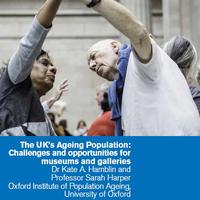Previous blogs have addressed the benefits of engaging with art and culture in later life, which include the promotion of social engagement, health and wellbeing and reducing isolation. Older people too have a lot of offer museums and galleries as visitors, staff, volunteers, members, donors and trustees. All too often a pessimistic picture of population ageing is presented in the media, generally related to concerns around rising health and social care costs and while undoubtedly an ageing population will produce change, there will be opportunities as well as challenges. Following on from our seminar series ‘Art, Museums, Wellbeing & Ageing’, and building upon the work to date carried out by the Age Friendly Museums network, the Institute has produced a report in collaboration with the British Museum, working towards developing a clearer understanding of population ageing and its impacts on the cultural sector.
It could be argued that as older adults contribute a great deal to galleries and museums through volunteering, visiting and donating, an ageing population could provide a boost to the sector. However, it is important to highlight that while successive generations are living longer, healthy and disability-free life expectancies are not rising at the same rate as general life expectancies, and differences are more pronounced along divisions such as wealth, education, geography and occupation. Our ageing population is going to be a diverse one, not only in terms of health and disability but also ethnicity when compared with previous generations. It will also be an ageing population with increasing responsibilities in terms of extending their working lives and the provision of care. Museums and galleries therefore need to consider these issues when they seek to engage with older people.
At the same time as the population is changing, museums and galleries too are facing their own opportunities and challenges. Their remits are expanding to include issues like social inclusion and health and wellbeing while their resources are shrinking. However the increased recognition of their role in health and wellbeing has opened up new possibilities for collaboration and expansion, with potential ‘win-win’ scenarios for all involved. Our report includes examples of interesting and fruitful collaboration and partnerships across different sectors. The report also highlights the important ways older people can contribute to museums and galleries in ways which go beyond volunteering, visiting and donating. We present examples where programmes are ‘done with’ rather than ‘done to’ older people, providing benefits for all involved. So while museums and galleries can provide a lot of benefits to older people– as diverse a group as they are – in terms of their wellbeing, health and social engagement, at the same time, older people have a contribution to make to museums and galleries.
The Final Report can be viewed here: The UK’s Ageing Population: Challenges and opportunities for museums and galleries.
About the Author:
Dr Kate Hamblin is a Senior Research Fellow at the Oxford Institute of Population Ageing. Kate is currently working on a follow-on project examining self-employment for older workers as well as a further collaboration with CIRCLE on a piece of research commissioned by SENSE (the deaf-blind charity) to explore telecare use by individuals with dual-sensory impairment. She is also engaged in a John Fell Fund project exploring the outcomes of the Museum of Oxford’s reminiscence programme and a study examining the work and retirement aspirations of older self-employed people.
Opinions of the blogger is their own and not endorsed by the Institute
Comments Welcome: We welcome your comments on this or any of the Institute's blog posts. Please feel free to email comments to be posted on your behalf to administrator@ageing.ox.ac.uk or use the Disqus facility linked below.













